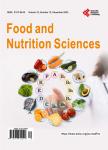Nutritional Status of Patients with Cutaneous Leishmaniasis from a Tropical Area of Bolivia, and Implications for Zinc Bioavailability
Nutritional Status of Patients with Cutaneous Leishmaniasis from a Tropical Area of Bolivia, and Implications for Zinc Bioavailability作者机构:Biomedical Research Institute San Simon University Cochabamba Bolivia Department of Food Technology Engineering and Nutrition Lund University Lund Sweden Department of Food Technology Engineering and Nutrition Lund University Lund Sweden Food and Natural Products Center San Simon University Cochabamba Bolivia Department of Nutrition San Simon University Cochabamba Bolivia
出 版 物:《Food and Nutrition Sciences》 (食品与营养科学(英文))
年 卷 期:2013年第4卷第10期
页 面:49-60页
学科分类:1002[医学-临床医学] 100201[医学-内科学(含:心血管病、血液病、呼吸系病、消化系病、内分泌与代谢病、肾病、风湿病、传染病)] 10[医学]
主 题:Nutritional Status Leishmaniasis Dietary Intake Anthropometrics Zinc Bioavailability Phytates
摘 要:Macro and micronutrient deficiencies are a significant problem among people in rural areas in developing countries. Deficiencies may lead to an impaired immune system making the organism vulnerable to infections and diseases. In this paper, the dietary intake, anthropometric measurements, zinc and copper levels in serum, of patients with cutaneous leishmaniasis (CL) are compared with a group of healthy controls and reference values. Results showed no significant differences in most nutrient intake or anthropometrics between patients and controls. However, serum zinc level of patients (80 μg/dl) was significantly lower (P 0.001) than in controls (85 μg/dl), likely explained by the presence of leishmaniasis. The median serum zinc level in both groups was below the reference values, even though their median zinc intake met the zinc recommendations from WHO. Consequently, besides the presence of leishmaniasis, serum zinc levels may be compromised by inhibitory components in their diet, such as phytates, as it is shown by the molar ratio phytate:zinc (Phy:Zn) that was between 11 and 19, while 15 is the level said to compromise zinc status. There were significant (P 0.05) negative correlations between serum zinc and Phy:Zn, for patients (r = - 0.413) and controls (r = - 0.410). In conclusion this study shows that patients with CL in Chapare, Bolivia had low serum zinc levels due to the leishmaniasis per se and the decreased zinc bioavailability in their diet. CL infection was not in direct association with the nutritional status indicated by the anthropometric or dietary assessments. However, dietary intake showed 5 essential nutrients below the nutrient recommendation in both groups.




